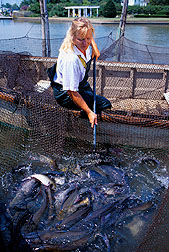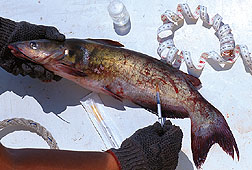Doctoring Fish—New Vaccines for Aquaculturists
|
|
Like people, fish have their share of diseases and need vaccines to keep them healthy. Agricultural Research Service scientists at Auburn, Alabama, have developed several of these vaccines and are now closing in on one that protects fish from a Streptococcus bacterium.
The agency's Aquatic Animal Health Research Laboratory is developing a new vaccine against Streptococcus iniae, says Phillip H. Klesius, who heads the Auburn unit. "S. iniae is an emerging bacterial pathogen in cultivated tilapia, hybrid striped bass, rainbow trout, yellowtail, eel, and turbot. Worldwide, streptococcal infections are reported in 22 fish species, both cultured and wild," he says.
S. iniae is recognized as one of the most problematic bacterial pathogens in intensively cultured tilapia and hybrid striped bass in the United States. Development of good health management practices and a vaccine to control it is a superior approach to using antibiotics or chemicals, Klesius says.
Klesius, ARS molecular biologist Craig A. Shoemaker, and ARS aquatic pathologist Joyce J. Evans are co-developing the vaccine. This team combines unique expertise in fish disease prevention. Members conduct basic research to understand immunity, transmission, and infection—particularly in hybrid striped bass and tilapia.
"We found the S. iniae bacterium possibly enters the nostrils of the fish from the water," says Evans, who is with the Auburn unit but based at Washington College in Chestertown, Maryland. She is researching fish health problems associated with fish kills and aquatic pathogens. "Finding out how bacteria enter and travel through the fish may aid in development of an effective vaccine," she says.
The higher the density of cultured fish, the more easily S. iniae is transmitted and the higher the mortality, says Shoemaker. "Signs of the disease in fish are abnormal behavior such as erratic swimming, whirling motion at the surface of the water, darkening of the skin, blindness, popeyes, and small lesions on the body, fins, and anus."
Antibiotics are currently used to control the streptococcal disease in fish. Surprisingly, the team's research indicates there are certain negative effects on fish health and immunity after antibiotic treatment for S. iniae. This indicates that antibiotic treatment suppresses streptococcal disease signs but doesn't completely eliminate the bacterium from treated fish.
Vaccine to the Rescue
These new findings are important determinants for developing a successful vaccine to fight S. iniae, which causes $150 million a year in losses. The ARS scientists are designing it to provide lifelong protection. In laboratory studies, it has reduced mortality in tilapia and hybrid striped bass by more than 80 percent.
Popular in Asian countries, tilapia is showing up on more U.S. menus. Since 1997, U.S. fresh and frozen tilapia imports have increased 28 percent and U.S. tilapia cultivation is expanding steadily. Hybrid striped bass consumption and production through cultivation are also increasing rapidly because of rising consumer demand for this excellent-tasting fish.
"We are currently developing plans to test the vaccine on a larger scale throughout the United States," Klesius says. "We are testing effectiveness of both injection and the bath immersion immunization that gives fish farmers more flexibility. This vaccine could potentially save producers money worldwide."
|
|
The ARS team has filed for a patent on the new vaccine for use in both small and larger sized fish.
More Catfish Disease Protection
Klesius and Shoemaker recently developed the first approved modified live-bacterium fish vaccine, one that protects young channel catfish against enteric septicemia (ESC). A major catfish disease caused by the bacterium Edwardsiella ictaluri, ESC costs catfish farmers as much as $60 million a year in losses. This new vaccine—made of a live E. ictaluri organism rendered unable to cause disease—prevents infection. ARS has filed for a patent on it.
Also called "hole in the head," enteric septicemia is characterized by lesions and holes in the fish's cranium, as well as by a bright-red color at the base of its gills and belly. It accounts for 70 percent of disease losses in catfish but has never been associated with human infection.
"In field studies," Shoemaker says, "the ESC vaccine reduced catfish mortality by 80 percent."
Not To Forget Tail Rot
Another emerging problem is the bacterium Flavobacterium columnare. It causes columnaris disease, sometimes called peduncle disease or tail rot (in aquarium species, cotton-wool mouth), a significant source of economic loss in cultivated catfish, hybrid striped bass, and other fish species. Currently, there is no means to successfully control this infection, says Klesius.
The scientists at Auburn are evaluating various vaccine formulations to prevent it. They have found that fish surviving columnaris disease are resistant or immune to reinfection. This shows that a future vaccine is possible.
Klesius and colleagues are also researching fish behavior and health problems related to fungal, algal, bacterial, and chemical toxins that have been implicated in fish kills in U.S. coastal waters. They have developed unique methods to culture brain cells from fish and determine the types of brain cell injury caused by toxins from infectious and noninfectious agents.
"We hope this research provides new insights into behavior, health, and immunity in wild and cultured fish exposed to toxic agents and pollutants found frequently in the United States. This research is a necessary part of ensuring a safe food supply," says Klesius.—By Tara Weaver-Missick, Agricultural Research Service Information Staff.
This research is part of Aquaculture, an ARS National Program (#106) described on the World Wide Web at http://www.nps.ars.usda.gov/programs/appvs.htm.
Phillip H. Klesius and Craig A. Shoemaker are at the USDA-ARS Aquatic Animal Health Research Laboratory, 990 Wire Rd., Auburn, AL 36831-0952; phone (334) 887-3741, fax (334) 887-2983.
Joyce J. Evans, USDA-ARS Aquatic Animal Health Research Laboratory, Washington College, 300 Washington St., Chestertown, MD 21620; phone (410) 810-7151, fax (410) 810-7451.
"DOCTORING FISH—New Vaccines for Aquaculturists" was published in the October 1999 issue of Agricultural Research magazine.








